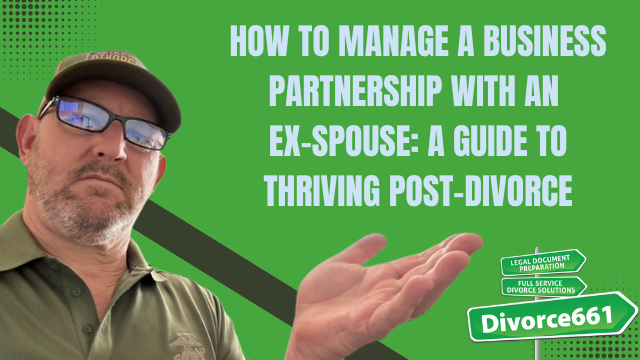How to Manage a Business Partnership with an Ex-Spouse?
Divorce is undeniably one of life’s most challenging transitions. When personal relationships end, the complexities can multiply—especially when you and your ex-spouse remain business partners. While divorce often marks the end of many shared endeavors, it doesn’t have to mean the end of your business partnership. With the right approach, clear communication, and proper legal frameworks, you can successfully navigate co-ownership after divorce and keep your business thriving.
Drawing from years of experience working with couples facing this unique challenge, I’m Tim Blankenship from Divorce661.com. In this article, I’ll guide you through the essential steps to manage a business partnership with your ex-spouse, highlighting key strategies and real-world examples to help you maintain professionalism and profitability post-divorce.
Understanding the Challenges of Business Partnerships After Divorce
Divorce itself is emotionally and legally complex. Add a shared business to the mix, and the stakes rise significantly. It’s common for emotions to run high, and the lines between personal and professional can blur. However, many couples successfully continue their business relationships after divorce by setting clear boundaries and expectations.
One of the most important realizations is that just because you’re no longer married doesn’t mean your business partnership has to end. If both parties are committed to professionalism and clarity, the business can continue to operate smoothly and even thrive.
Define Roles and Responsibilities Clearly
After divorce, the first and most crucial step is to clarify each partner’s roles and responsibilities within the business. This clarity prevents misunderstandings and helps keep operations running efficiently.
- Who handles what? Define specific duties for each partner. Whether it’s managing finances, operations, sales, or client relations, knowing who is responsible for what reduces overlap and conflict.
- Decision-making process: Establish how decisions will be made moving forward. Will decisions require unanimous consent, or will one partner have final say on certain issues?
- Profit sharing: Agree on how profits will be divided. This should be fair and reflect each partner’s contribution and investment in the business.
Clear role definition helps separate personal feelings from business operations, ensuring that the company’s needs come first.
The Importance of Updated Legal Agreements
Next, you must update or create a comprehensive written agreement. Ideally, this should take the form of a revised operating agreement or partnership contract that reflects your new post-divorce business reality.
Why is this so important? Because without a formal agreement, misunderstandings and disputes are more likely to arise. A well-drafted legal document will cover:
- Dispute resolution: Procedures for handling disagreements to avoid costly and damaging conflicts.
- Buyout options: Clear terms for how one partner can buy out the other if one decides to leave the business.
- Potential sale: Guidelines for how the business could be sold in the future, including how proceeds are divided.
These provisions provide a roadmap to protect both the business and each partner’s interests, offering peace of mind and reducing uncertainty.
Real Client Success Story: Keeping a Consulting Firm Thriving Post-Divorce
To illustrate how this works in practice, let me share a story from our experience at Divorce661. We recently worked with a couple who co-owned a successful consulting firm. They divorced amicably but were determined to keep their business going strong.
We helped them by:
- Documenting a new operating agreement that clearly outlined their roles and responsibilities.
- Defining individual duties to avoid overlap and potential conflict.
- Creating a buy-sell plan that prepared them for the possibility that one partner might want out in the future.
The result? Their business didn’t just survive the divorce—it continued to thrive. They maintained professionalism, kept the business growing, and avoided emotional disputes that often derail such partnerships.
Setting Strong Boundaries: Separating Business from Personal
Another key to success is establishing strong boundaries between your personal relationship and your professional partnership. This means:
- Communicating only about business during meetings and interactions related to the company.
- Keeping personal issues out of the workplace to maintain a professional atmosphere.
- Using neutral channels or third-party mediators if necessary to resolve conflicts.
By compartmentalizing your interactions, you reduce emotional triggers and focus on what matters most—the health and success of your business.
How Divorce661 Supports Couples Managing Business Partnerships Post-Divorce
At Divorce661, we understand that every divorce is unique, especially when shared businesses are involved. We offer tailored support to help you navigate this complex situation smoothly:
- Paperwork guidance: We assist you in updating all necessary legal documents, ensuring they accurately reflect your new arrangement.
- Customized agreements: Our team helps draft and revise operating and buy-sell agreements tailored to your business and personal needs.
- Professional connections: We connect you with trusted professionals—such as accountants, mediators, and business attorneys—to provide specialized support.
- Peace of mind: Our goal is to help you protect your business interests while maintaining your mental and emotional well-being.
Whether you’re in California or beyond, our remote services make it easy to get expert help wherever you are.
Key Takeaways: How to Make Your Business Partnership Work After Divorce
- Communicate clearly: Keep lines of communication open, professional, and focused on the business.
- Define roles and responsibilities: Know who is responsible for what to avoid confusion and conflict.
- Update legal agreements: Have a revised operating or partnership agreement that covers all critical aspects of your business relationship.
- Plan for the future: Include buyout and sale provisions to prepare for possible changes down the line.
- Set boundaries: Separate personal emotions from business decisions to maintain professionalism.
Final Thoughts
Managing a business partnership with an ex-spouse can be challenging, but it is absolutely possible with the right mindset and tools. By focusing on clear communication, strong legal agreements, and strict boundaries, you can protect your business and your peace of mind.
Remember, divorce doesn’t have to mean the end of your entrepreneurial journey together. With commitment and professionalism, your business can continue to grow and succeed.
If you’re currently co-owning a business with your ex and want to ensure everything runs smoothly, I encourage you to visit Divorce661.com to schedule a free consultation. We’ll help you create a clear plan to keep your business and personal life separate—and successful.
“Their business didn’t just survive, it continued to thrive.” — The story of a couple who successfully maintained a consulting firm post-divorce with our help.
Feel free to share your own experiences or questions about managing business partnerships after divorce in the comments. Your insights could help others navigating the same path.




